Gear Reviews
RMI Sonic Spark, Clean Boost, and Classic Boost Reviews
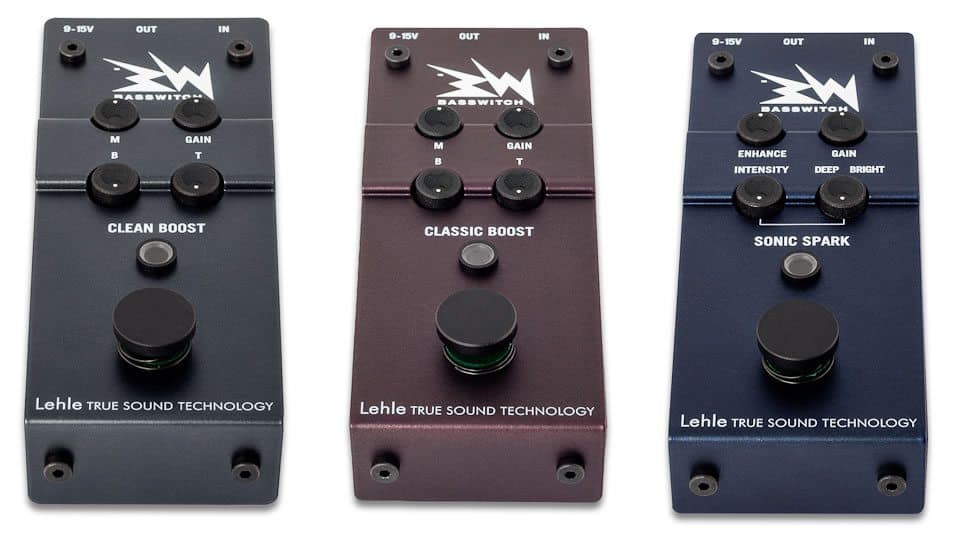
In the not too distant past, Bass Musician Magazine featured a review of the RMI Basswitch; a fully featured and beautifully executed preamp/DI pedal that provides a variety of solutions for bassists, and some slick features that have rightfully earned it the “swiss army knife for bass players” title. More recently, they added a line of smaller pedals to their roster; each designed to provide a specific flavor of EQ and boost options. The RMI Clean Boost, Classic Boost, and Sonic Spark offer up some very usable tonal options, and share the exceptionally robust build quality and design aesthetic that we loved about the RMI Basswitch. We had an opportunity to put the new RMI pedals through their paces, and they did not disappoint.
Like all the RMI pedals, the Classic Boost offers a wide range of tones available via the 3 band EQ and the gain control of the pedal, and it was apparent to me that the Clean Boost is the most ‘middle of the road’ of the 3, tonally speaking. There is a neutrality and transparency to its tone that really helps to push forward the native sound of your bass. My first impression was that it had less impact on my tone than I felt I was wanting (it is an ‘effect’ after all), but after playing around and gigging with it, I realized that its clean, transparent gain is actually ideal for my needs. It stayed out of the way of my instrument and offered exactly what it advertised: “clean boost”. Even with the gain bumped up and the EQ controls boosted a little, the Clean Boost retained the fat glassy tone of my active 5 string jazz, the woody thump of my flatwound strung P bass, and the midrange complexity of my chambered 6 string. Whereas the other RMI pedals imparted more of their ‘thing’ to my signal chain, the Clean Boost allowed me to keep the sound and feel of my instrument intact, while pushing my signal chain and the front end of my preamp a little harder. One application I really thought the clean boost excelled at was toggling on and off for fingerstyle and slap sections in a song. It allowed me to dig in while playing fingerstyle, and then switch to a hotter/super responsive and dynamic slap tone that called for a lighter touch. I could see this pedal being an excellent choice for someone looking for the kind of boost pedal that preserves the instruments tone, and just offers more of it.
Up next is the Classic Boost, which, according to RMI is designed to benefit passive or ‘classic’ P/JJ/PJ style instruments. Much like the Clean Boost, the Classic Boost serves up great tone and noise free gain, and also preserves the sound of your instrument. Where this pedal differs from the Clean Boost, is that it has a little more shape to its tone profile, which again is designed to complement passive or traditional style basses. In my testing I found the Classic Boost to perform as expected. Not quite as glassy or wide as the Clean Boost, the Classic Boost is a bit more ‘in the box’ so to speak. It seems to have less extension on the top and bottom end of the frequency range, and I felt that it helped pocket the sound of my P bass even more effectively than the Clean Boost. Without getting too far into the realm of subjectivity, I would say that the Classic Boost helped focus the midrange on my Fender style instruments. Like the Clean Boost though, the EQ is powerful and super usable, and an array of legit tones are available. Suffice to say, this is the one that really shines if you tend to stick with Fender or MusicMan style basses.
This is the hardest of the three RMI pedals to define. I’ll start with RMI’s product description of the Sonic Spark, which is that of a “harmonic overtone generator”. Instead of a 3 band EQ, the Sonic Spark offers controls for: Gain, Enhance, Intensity and a Deep/Bright blend for optimal tonal tweaking. Firing up the Sonic Spark, I was immediately rewarded with what I would call “tube-like bigness”. Plugged into a rig that I consider very clean and dry, the Sonic Spark spoke with a rich, overtone-laden voice that seemed to accentuate the entire range of the instrument. At higher gain levels, the pedal offers creamy grit, but at lower gain levels, I found the Sonic Spark imparted a hefty weight and thickness to the sound that I can only describe as “tubey”. I had a great time exploring the range of the pedal, especially playing with the deep/bright knob, which serves as a global EQ for shaping tone in those general directions. I was able to find a handful of great “always on” settings, and some sweet solo/boost type settings as well. When really pushed, the Sonic Spark dishes out its fair share of snarl too, which, while not my thing, is undeniably fun. Best of all, it sounds authentic, and has a dynamic feel that really resembles the response of a tube power section.
What else is noteworthy about these RMI pedals? Well, for starters, the componentry in these pedals are second to none. Gold plated relays, loss-free silent footswitches, ultra smooth taper pots, and a discrete JFET input stage all contribute to a smooth operating effect with ultra low noise operation (110db “with very little noise”). Another cool feature of the RMI pedals is their 18V internal power supply. The pedals will accept any 9-15 volt AC or DC power supply, but internally, the voltage is rectified up to 18V, for better headroom. This offers some nice flexibility for pedalboard users, who are constantly trying to juggle the available power channels on units like the Voodoo Labs pedal power 2 and similar isolated power supply units.
There really isn’t anything to dislike about these pedals. Anything I could potentially complain about would be subjective at best, and most certainly a nitpick. For my purposes they did exactly what they’re designed to do, and they did it well. RMI gets extra points for: 1. top mounted jacks (pet peeve alert: wasted space on a pedal board from patch cable jacks protruding from the sides of pedals), and 2. The slight overhang of the faceplate, offering a small degree of additional protection at jack insertion points. I also dug the mellow vibe of the soft blue LED light to indicate that the pedal was engaged.
These RMI pedals offer a lot of usable tone shaping for bassists looking to craft their tone in simple yet sophisticated ways. The Clean and Classic Boost sell for $259, while the Sonic Spark sells for $299. Not exactly cheap, but well worth the price of admission if you’re looking for some very savvy EQ and tone shaping options in an exquisitely well designed and constructed pedal. Head over to www.lehle.com for more information.
Bass Videos
Review: CrystalBright Rombo Picks
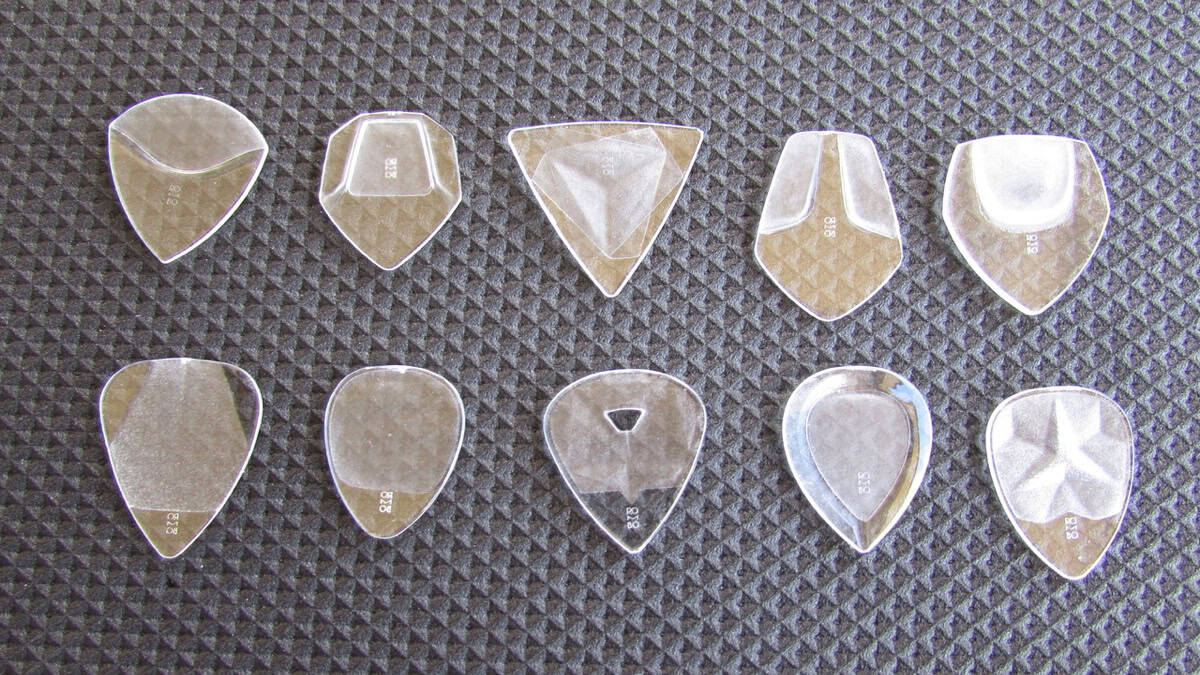
CrystalBright Rombo Picks
PR SamplePlaying bass with a pick is still a touchy subject in our community. I believe you should be able to use whatever you need to get your sound. Even though I mostly play with my fingers, I like to check out innovative new picks that might have something new to offer, sonically speaking.
Judith and Carlos from Rombo recently contacted me about a new material called CrystalBright that they have been researching for the last 12 months and offered to send some prototype picks. After trying them out, I put together this video with my findings.
For more info check out @rombopicks
Gear
New Joe Dart Bass From Sterling By Music Man

Sterling by Music Man introduces the Joe Dart Artist Series Bass (“Joe Dart”), named after and designed in collaboration with the celebrated Vulfpeck bassist.
Above photo credit: JORDAN THIBEAUX
This highly-anticipated model marks the debut of the Dart bass in the Sterling by Music Man lineup, paying homage to the Ernie Ball Music Man original that all funk players know and love. The bass embodies many of the original model’s distinctive features, from its iconic minimalist design to the passive electronics.

The design process prioritized reliability, playability, and accessibility at the forefront. Constructed from the timeless Sterling body, the Dart features a slightly smaller neck profile, offering a clean tone within a comfortable package. The body is crafted from soft maple wood for clarity and warmth while the natural finish emphasizes the simple yet unique look.
Engineered for straightforward performance, this passive bass features a ceramic humbucking bridge pickup and a single ‘toaster’ knob for volume control. Reliable with a classic tone, it’s perfect for playing in the pocket. The Dart is strung with the all-new Ernie Ball Stainless Steel Flatwound Electric Bass Strings for the smoothest feel and a mellow sound.

The Sterling by Music Man Joe Dart Bass is a special “Timed Edition” release, exclusively available for order on the Sterling by Music Man website for just one month. Each bass is made to order, with the window closing on May 31st and shipping starting in November. A dedicated countdown timer will indicate the remaining time for purchase on the product page. Additionally, the back of the headstock will be marked with a “2024 Crop” stamp to commemorate the harvest year for this special, one-of-a-kind release.
The Joe Dart Bass is priced at $399.99 (MAP) and can be ordered globally at https://sterlingbymusicman.com/products/joe-dart.
To learn more about Joe Dart, visit the official Vulfpeck artist site here https://www.vulfpeck.com/.
Gear Reviews
The Frank Brocklehurst 6-String Fretless Bass Build
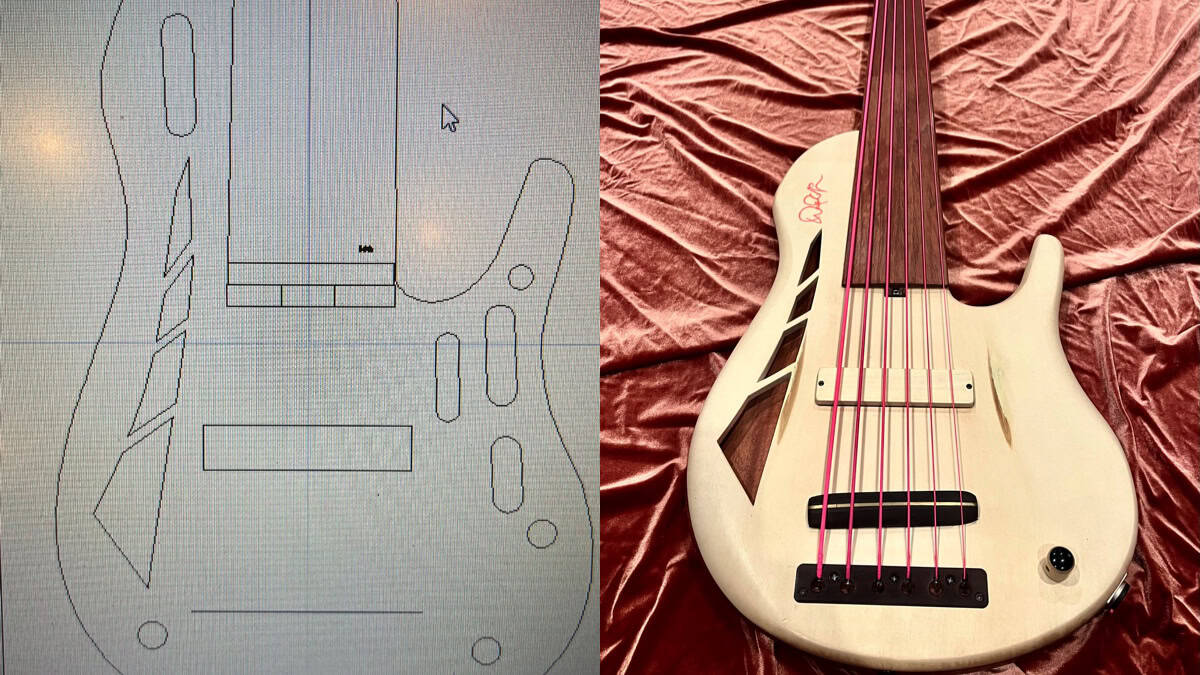
A few months ago, my Ken Bebensee 6-string fretted bass needed some TLC. You know, the one rocking those Pink Neon strings! I scoured my Connecticut neighborhood for a top-notch luthier and got pointed to Frank Brocklehurst, F Brock Music. He swung by my place, scooped up the bass, and boom, returned it the next day, good as new. Not only that, he showed up with a custom 5-string fretted bass that blew me away. I couldn’t resist asking if he could whip up a 6-string fretless for me.
Alright, let’s break down the process here. We’ve got our raw materials: Mahogany, Maple, and Holly. Fun fact – the Mahogany and Maple have been chilling in the wood vault for a solid 13 years. Frank is serious about his wood; they buy it, stash it away, and keep an eye on it to make sure it’s stable.

First up, they’re tackling the Mahogany. Frank glues it together, then lets it sit for a few days to let everything settle and the glue to fully dry. After that, it’s onto the thickness planer and sander to get it nice and flat for the CNC machine. The CNC machine’s the real star here – it’s gonna carve out the body chambers and volume control cavity like a pro.

While the Mahogany’s doing its thing, Frank goes onto the neck core. Three pieces of quartersawn maple are coming together for this bad boy. Quartersawn means the grain’s going vertical. He is also sneaking in some graphite rods under the fingerboard for stability and to avoid any dead spots. The truss rod is going to be two-way adjustable, and the CNC machine’s doing its magic to make sure everything’s just right.

Now, onto the design phase. Frank uses CAD software to plan out the body shape, neck pocket, chambering, and those cool f-holes. I had this idea for trapezoid F-holes, just to do something different. The CAD software also helps us map out the neck shape, graphite channels, and truss-rod channel with pinpoint accuracy.

Once everything’s planned out, it’s CNC time again. Frank cuts out the body outline, neck pocket, and the trapezoid F-holes. Then it’s a mix of hand sanding and power tools to get that neck just how we like it. Oh, and those f holes? We’re going for trapezoids of different sizes – gotta keep things interesting.

Next step: gluing that neck into the pocket with some old-school hide glue. It’s got great tonal transfer and can be taken apart later if needed. Then it’s onto hand-carving that neck-body transition.

For the custom-made bridge, Frank uses brass for definition and Ebony for tonal transfer and that warm, woody sound.

BTW, for tunes, Frank went with Hipshot Ultralights with a D Tuner on the low B. This way I can drop to a low A which is a wonderful tone particularly if you are doing any demolition around your house!
Now it’s time for the side dots. Typically, on most basses, these dots sit right in the middle of the frets. But with this bass, they’re placed around the 1st, 3rd, 5th, 7th, 9th, and 12th frets.

Frank’s got his pickup hookup. Since the pickup he was building wasn’t ready, he popped in a Nordstrand blade to give it a whirl.

It sounded good, but I was itching for that single-coil vibe! And speaking of pickups, Frank showed me the Holly cover he was cutting to match, along with all the pink wire – talk about attention to detail!

A couple of things, while it is important for me to go passive, it is equally important for me to just go with a volume knob. Tone knobs are really just low-pass filters and the less in the way of a pure sound for me, the better.
Finally, it’s string time! As usual, I went for the DR Pink Neon strings. Hey, I even have matching pink Cons…Both low tops and high!

Once we’ve got everything tuned up and settled, we’ll give it a day or two and then tweak that truss rod as needed. And voila, we’ve got ourselves a custom-made bass ready to rock and roll.

I want to thank Frank Brocklehurst for creating this 6 string beast for me.
Gear Reviews
Review Transcript: BITE Custom Bass – The Black Knight PP Bass
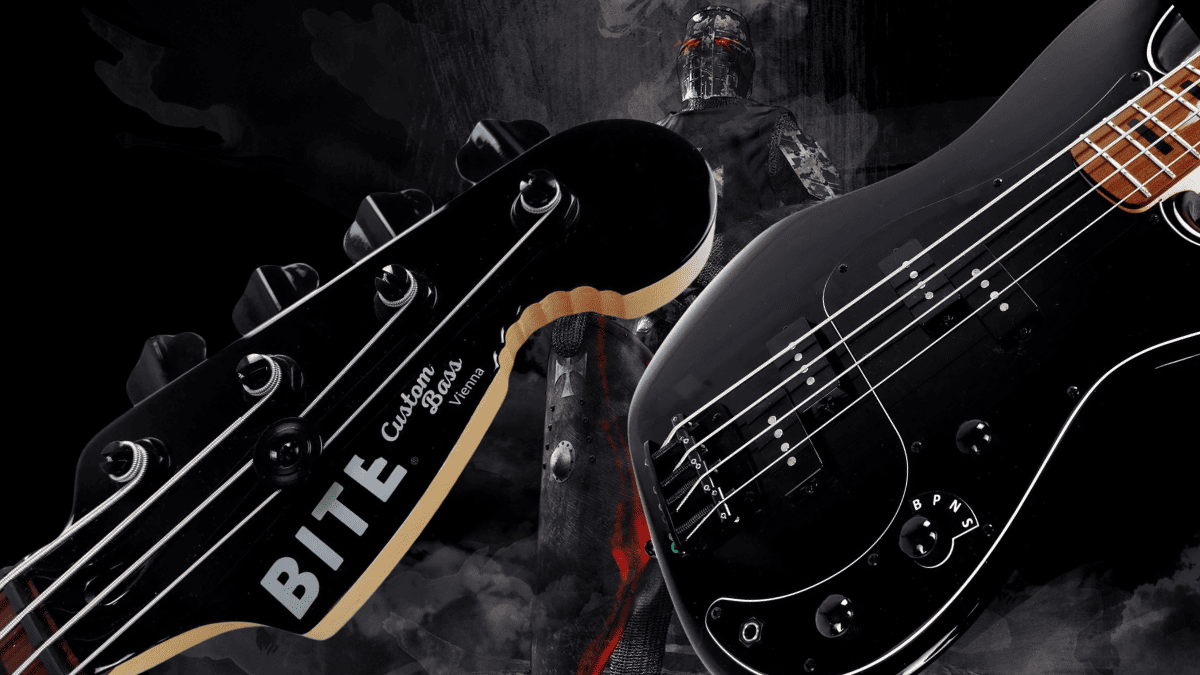
This is a written transcript of our video review of the BITE Custom Bass Black Knight PP Bass originally published on March 4, 2024
BITE Custom Bass – The Black Knight PP Bass Review…
Bass Musician Magazine did a review on a Steampunk bass from BITE Guitars about three years ago, it was an amazing instrument, and we were very impressed. Now we’re happy to bring you another BITE bass, the Black Knight PP.

Everybody needs a P-type bass, it’s the standard of bass. If you’re recording, they want you to have a P bass. So why not have something that gives you a little more by having two instead of one P pickup. That’s the idea of this bass, it’s the first thing that leaps out: the double P pickup configuration.

Installing two of their 1000 millivolt split-coil pickups, BITE then went one step further and wired them up in a 4-way parallel/series circuit, a look at the controls reveal a 4-way rotary selector:
The first position, marked “B”, gives you the bridge pickup by itself.
The second position, marked “P”, gives you the bridge and neck pickups in parallel mode, that’s the traditional J-type circuit, it reduces output due to the physical law of parallel circuits.
Position number 3 is marked “N”, it gives you the neck pickup by itself.
And finally, number 4, marked “S”, gives your bridge and neck in a series (humbucking) mode which adds up resistances and thus boosts output. The other two controls are master volume and master tone.

What’s more, like every BITE bass, this one also has a reinforced headstock heel designed to give it extra output and sustain. The BITE website features a graph and explanation of what they have done to the heel, as compared to traditional headstocks.

A look at the body reveals a beautiful Black Blast body finish and underneath that we have alder wood. The bass has a matching headstock with a 4-in-line tuner setup and the traditional bite out of it, so everybody will know what kind of bass you’re playing. The pickguard is 3-ply black, the neck is vintage tinted hard maple and it has a satin speed finish at the back which keeps your thumb from sticking.
On top of that, there’s a clear-coated roasted black locust fretboard with black blocks marking the frets. The nut is a black Graph Tec nut, we’ve got diamond dome control knobs, and the tuners are lightweight compacts with cloverleaf buttons and a 1:17 ratio precision gear. The bridge is a Gotoh brass bridge with 19-millimeter string spacing.
Overall measurements: we’ve got a standard 34″ scale, a 1.65″ width nut and a C neck profile. This bass weighs 8.2 pounds, or 3,7 kilograms for our metric friends, and it uses standard 18% nickel silver frets.
Taking a closer look at the sound, this bass is a joy to play. The BITE proprietary 1000 millivolt pickups deliver an extraordinary amount of output which is surprising considering this is a passive instrument. You may even want to set your amp to active mode because of all of the juice you’re getting out of this guy.
The tonal possibilities are very versatile, it’s a straight P if you want but also much more with those different arrangements of the circuitry. So why have multiple basses when you’ve got one that can give you your basic P plus a lot more?
To sum it up, the Black Knight PP is an amazing instrument. The attention to detail that BITE puts into their basses is second to none. This bass is also amazingly balanced and gorgeous to hold and feel with the satin neck finish.
For more information, visit online at bite.guitars/product/black-knight-pp
Bass Videos
Reviews: Phil Jones Bass Compact Plus 450 and Bass Engine 17
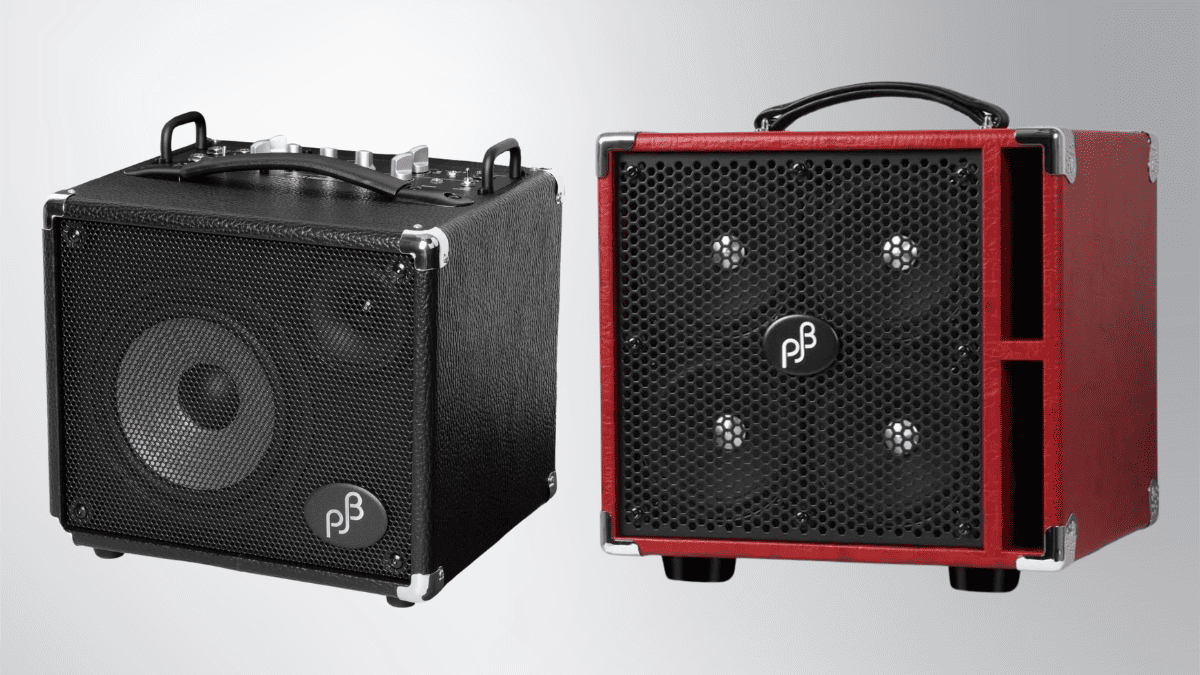
Phil Jones Bass Compact Plus 450 and Bass Engine 17 Reviews…
In this issue, we take an in-depth look at two new amps from Phil Jones Bass, the Compact Plus 450 and Bass Engine 17.
For more information, visit online at pjbworld.com













